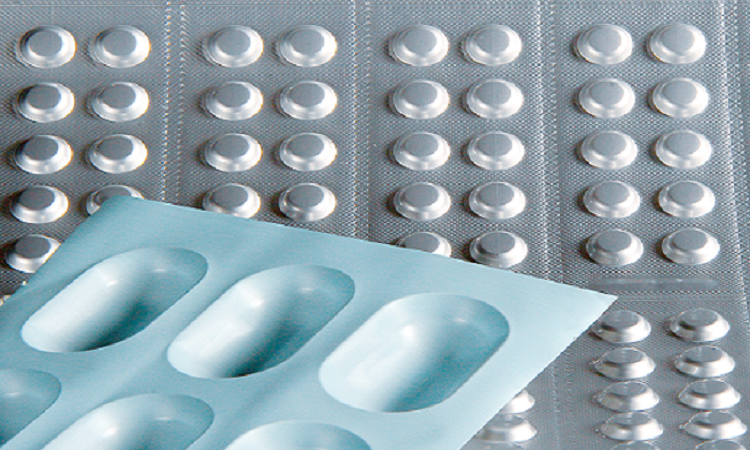8011-H18 temper PTP medicine foil production process
The tensile strength σb and elongation δ were tested by sampling from the finished aluminum foil. The testing process was carried out on the WDW-10 electronic universal testing machine. The experimental process is carried out in accordance with the relevant regulations of GB/T228-2002, the tensile speed is 5.0mm/min, and the average value of 3 samples is taken for each measured value; the burst strength test is carried out on a BT-6 punching cup testing machine according to the national standard . Inspect the size and number of pinholes in the finished aluminum foil.
At the same time, take samples to test the dyne value on the surface of the finished product. The plate shape should be flat without warping, and the width should meet user requirements. The performance test results and surface tests were comprehensively analyzed, so as to comprehensively evaluate the quality of the PTP aluminum foil substrate produced by using the cast-rolled billet, and finally determine the best production process.
The mechanical properties of the PTP aluminum foil substrate are required to have a σb greater than 180Mpa and a rupture strength of more than 300Kpa. The purpose of intermediate annealing is to eliminate work hardening and internal stress and restore plasticity. At the same time, high temperature annealing can refine the recrystallized grains of industrial pure aluminum sheets and strips, redistribute the precipitated compounds, and have an important impact on the mechanical properties of the final product.
However, if the annealing temperature is too high, the grains will be coarsened. By changing the annealing system in the process plan, that is, reducing the annealing temperature from 480 to 500 °C to 450 to 470 °C, the tensile strength is increased to more than 180Mpa. In the process scheme, the thickness during intermediate annealing was changed from 2.5mm to 1.5mm. From the point of view of processing rate, increasing the total processing rate after annealing can improve the tensile strength of aluminum foil through work hardening. However, in the actual production process, due to the increase in processing rate when the aluminum sheet and foil are rolled, it means that the deformation work increases. About 80% of the deformation work will be converted into deformation heat, which is enough to make the foil reach the recovery temperature. At this time, the aluminum foil Instead, it softened.
The requirements for the tensile strength of the medicated foil are mainly in the production process of the PTP aluminum foil, if the strength is too small, the foil will break. If the broken foil is located in the drying tunnel, reconnection is a more troublesome thing, so it will have a greater impact on production.
Since the drug will reduce the efficacy or deteriorate due to the entry of oxygen, water vapor and light, the requirements for the pinhole degree of the PTP aluminum foil substrate are relatively strict. There are three main factors that affect pinhole degree, metallurgical quality, impurity content and compound size. Statistics show that the number of pinholes in aluminum foil increases with the increase of inclusion content and compound size, and increases exponentially with the thickness of aluminum foil.
The metallurgical quality and impurity content are controlled by the smelting process and melt purification before casting, while the size of the compounds is controlled by casting, cold rolling and heat treatment. When the temperature was lowered, the size of the total primary crystal compound gradually decreased, the sharp corners were dissolved, the number of smooth and elongated compounds decreased, and the degree of spheroidization increased significantly. When the PTP drug foil base foil is rolled to a certain thickness, the size and number of pinholes will decrease accordingly due to the reduction of compound size and the uniform distribution of the compound.
In the process of aluminum foil production, a large amount of lubricating oil needs to be used to cool and lubricate the aluminum plate. The supply status of PTP medicated foil is H18, and it is delivered as hard aluminum foil, so the control requirements for oil on the surface of aluminum foil are quite strict. The surface tension test of aluminum foil before leaving the factory must reach 32×10-3N/m to meet the needs of grease printing.
The results show that high-quality PTP aluminum foil base material can be produced by using 8011 aluminum alloy casting and rolling billets, and intermediate annealing is carried out when it is cold rolled to 1.5mm, and the annealing system is 450~470℃/11~13h. The combination of rolling and foil rolling processes can obtain PTP aluminum foil substrates with high surface quality and mechanical properties.
